- Overview of Horse Gaits
- Types of Performance Classes for Stock Type and Sport Horse Breeds
- Hunter Events
- Western Performance Events
- Classes Judged on the Rider
- Summary
When competing in youth horse judging contests or events at horse shows, it is important to have a good understanding of basic performance events that may be encountered. This publication is designed to give a basic overview of common performance classes. It is by no means comprehensive of all events that may be seen and does not go in-depth on any one event. For more specific information on the rules of each event, it is important to review the rulebooks/handbooks of the governing equine organizations, such as the American Quarter Horse Association, the United States Equestrian Federation, the United States Hunter Jumper Association and the National Reining Horse Association. Most organizations have websites with links to their rulebook or handbook.
Overview of Horse Gaits
Before evaluating any type of riding or performance class, it is important to first understand the basic gaits that horses may be required to perform. Typically when judging stock horse breeds (e.g., Quarter Horses, Paints and Appaloosas) and sport horse breeds (e.g., Thoroughbreds and Warmbloods), the four gaits seen are the walk, trot (or jog), canter (or lope) and hand gallop. When judging classes that have any basis on quality of movement, it is important to understand the proper footfall pattern of each gait.
A walk is a slow, four-beat gait in which each hoof falls independently of the other legs, in the pattern of hind leg then front leg on one side followed by hind leg then front leg on the other side.
A trot (or jog) is a medium-paced gait (approximately 4 m/s) that consists of two beats; the legs move in diagonal pairs.
The canter (or lope) is another medium-paced gait that is roughly twice as fast as the trot (approximately 8 m/s). It is a three-beat gait and generally the horse is required to be on the correct lead, meaning that the inside front leg is the leading leg. For example, if the horse is traveling on a circle to the right, the left hind leg moves forward and strikes the ground first, followed by the diagonal pair of the right hind and left front legs moving forward and striking the ground at the same time, finished by the right front leg moving forward independently and striking the ground last. When the horse changes directions, it is required to do some type of lead change. A simple lead change involves the horse slowing down to another gait and then picking up the new lead, whereas a flying lead change is a more advanced maneuver and involves the horse lifting or suspending his whole body into the air to change his leg position to the other lead without breaking gait.
A gallop is a four-beat gait that is faster than the canter and requires the horse to lengthen its stride. It has a similar rhythm and foot fall pattern as the canter but the horse is moving faster and instead of having a middle diagonal leg pair hitting the ground at the same time, each foot strikes the ground independently. For instance, when traveling left, the horse will move forward and strike the ground first with its right hind, then its left hind, then its right front, then its left front leg.
A hand gallop refers to the horse performing a gallop in a manner that is controllable by the rider; often in classes with larger numbers it simply becomes a slight extension of the canter since horses cannot gain enough speed to actually break the diagonal footfall pattern (Figure 1).
.JPG)
.JPG)
.JPG)
.JPG) Figure 1: Horse gaits. From top: walk, trot (jog), lope (canter), controlled gallop.
Figure 1: Horse gaits. From top: walk, trot (jog), lope (canter), controlled gallop.Other tasks the horse may have to perform are the halt and backing up. A halt requires that the horse stop completely. To do this correctly, the horse must shift its weight to its hindquarters rather than bracing with its front legs to stop. The back up is a movement where the horse moves backwards. It is a two-beat gait with the horse's legs moving backwards in diagonal pairs (same leg pairs as a trot but backwards). The horse should move backwards willingly and obediently and should easily flex at the poll. In most all disciplines, horses are penalized for excessive head movement, reluctance to move backwards and not backing up in a straight line.
Types of Performance Classes for Stock Type and Sport Horse Breeds
Many different classes and events showcase the different breeds and gaits within a horse breed. Judging in most classes is based on quality of the horse's movement and/or maneuvers as well as obedience and manners. It would be impossible in the scope of this publication to go into great detail on each class offered for every type of horse; however, each breed association and horse show association publishes specific details on class protocols and judging criteria in their rulebooks. This publication describes the judging criteria for some of the more commonly seen performance events for stock type and sport horse breeds, including hunter under saddle and over fences, western pleasure, horsemanship and equitation, and reining.
Hunter Events
The hunter discipline originated from foxhunts in England. This style of riding is traditionally more of a “forward seat” where the rider's body is still centered over the middle of the horse but is inclined forward to move with the horse. Hunter horses traditionally covered lots of terrain and needed to have long, smooth strides with the ability to jump obstacles safely. Today, there are many different hunter events that encompass work with and without jumps. Almost all hunter events emphasize good movement and athletic ability.
Hunter Under Saddle
Hunter under saddle classes are judged on the flat (not over jumps) at the walk, trot and canter in both directions. Horses are judged on their way of moving and obedience. These horses originated from the days of fox hunting and should be suitable for riding over long stretches of terrain and athletic enough to be able to jump obstacles (though no obstacles are present in hunter under saddle classes).
The horse's frame refers to the way the horse carries itself (head carriage, stride length, etc.). The hunter horse should have a long, relatively low frame. The horses should have a long, ground-covering stride and very little knee action. The knees should not bend very high but the horse should move forward freely from the shoulder to maximize the amount of ground covered, without looking rushed. The hunter horse should bring its hind legs well under its body to push itself forward (the hind foot should fall in the track of the front foot) and should appear to carry more of its weight on its hind end than on its front end. The head should be carried in a relaxed manner; the poll should be slightly above the height of the withers and flexed so that the nose is slightly in front of a straight line drawn from the poll perpendicular with the ground (Figure 2a). It is acceptable for the horse to carry its nose slightly in front of this vertical position; however, it is unacceptable for the horse to be behind this vertical position. Horses that are over-flexed (Figure 2c) or not on the bit (Figure 2d) may be penalized.
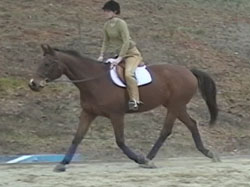 Figure 2: Examples of hunter horse frames. The horse in figure 2a shows a relaxed and natural head carriage desirable in the hunter ring.
Figure 2: Examples of hunter horse frames. The horse in figure 2a shows a relaxed and natural head carriage desirable in the hunter ring.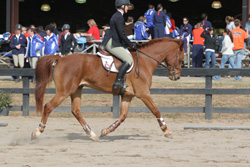 Figure 2: Examples of hunter horse frames. The horse in figure 2b is yielding willingly to the bit but shows too much flexion at the poll for a typical hunter horse.
Figure 2: Examples of hunter horse frames. The horse in figure 2b is yielding willingly to the bit but shows too much flexion at the poll for a typical hunter horse.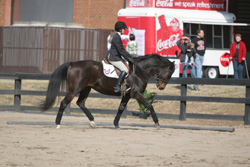 Figure 2: Examples of hunter horse frames. The horse in figure 2c is “overflexed” (its nose comes back too close to its chest) and would be penalized.
Figure 2: Examples of hunter horse frames. The horse in figure 2c is “overflexed” (its nose comes back too close to its chest) and would be penalized.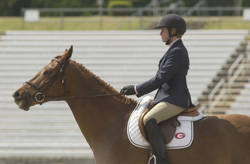 Figure 2: Examples of hunter horse frames. The horse in figure 2d is “not on the bit” and appears to be resisting its rider and stiffening its head and neck against the rein pressure.
Figure 2: Examples of hunter horse frames. The horse in figure 2d is “not on the bit” and appears to be resisting its rider and stiffening its head and neck against the rein pressure.The horse should be alert but relaxed and should always be obedient and responsive to its rider. It should easily and willingly extend its stride when asked but still appear to be in perfect control; it may be asked to perform an extended trot or a hand gallop. The hunter horse should move correctly without interfering (i.e., should not wing in or out or forge). A hunter may also be asked to stop and stand quietly and to back easily. When performing these maneuvers, the horse should be obedient, attentive, relaxed and show no signs of resistance. The hunter's stride should be smooth and rhythmical with a consistent pace kept throughout the duration of the class, and in spite of having a long flowing stride it should never look fast or out of control.
While the hunter under saddle horse is never asked to jump an obstacle, it should look as if it could easily jump an obstacle if needed. This means that the horse should possess forward momentum while carrying the majority of its weight on its hindquarters and have a smooth, sweeping stride.
Hunter Over Fences
In most hunter over fences classes, the horse is asked to jump a course of obstacles (approximately eight jumps) ranging anywhere from a few inches to 4 feet in height, depending on the class and show specifications. The horse is judged on its jumping style, obedience and way of going. The horse should carry itself in the same frame and have the same desired movement as described in the “hunter under saddle” section. The most important judging criterion for this class is that the horse negotiates all obstacles in a safe and workmanlike manner.
Safety of horse and rider ranks first when evaluating this class. It is important that the horse maintains an even and cadenced stride both approaching the fence and upon landing after the fence, without picking up or losing speed. The horse should never break from the canter into a slower gait until the course is completed. Horses should always maintain the correct lead for the direction they are traveling on course, and all lead changes performed should be flying (simple lead changes are penalized). The horse should form an arc over the middle of the fence and reach with its head and neck rather than stiffening (Figures 3a,b). The horse's back should be rounded in the air rather than stiff and “flat” to enable the horse to lift its knees from the shoulder to clear the obstacle.
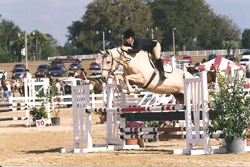 Figure 3: The horse in figure 3a is exhibiting a nice arc over the obstacle. It is reaching with its head and neck and rounding its topline.
Figure 3: The horse in figure 3a is exhibiting a nice arc over the obstacle. It is reaching with its head and neck and rounding its topline.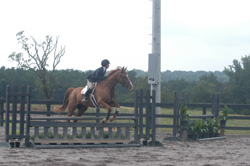 Figure 3: The horse in figure 3b is jumping “flat.” It has stiffened and raised its head and neck and therefore cannot round its back and lift its shoulders.
Figure 3: The horse in figure 3b is jumping “flat.” It has stiffened and raised its head and neck and therefore cannot round its back and lift its shoulders.Rounding over the jump enables the horse to lift its shoulders and is of particular importance. A horse that “hangs” its legs has a much higher risk of becoming entangled in the jump and falling. If the horse is jumping correctly, a line that is parallel to the ground should be able to be drawn from the top of the leg (where the front leg meets the shoulder) to the knee (Figure 4). The knees should also be even rather than the horse “splitting his knees” (Figure 5).
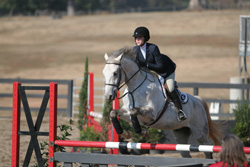 Figure 4: A horse jumping with correct front leg technique. Note that the knees are the same height and the foreleg is parallel with the ground.
Figure 4: A horse jumping with correct front leg technique. Note that the knees are the same height and the foreleg is parallel with the ground.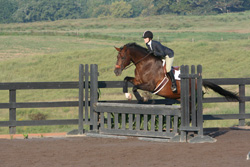 Figure 5: Incorrect front leg technique. This horse has “split” his knees and one leg is higher than the other, making the horse more prone to catch the lower leg on the obstacle.
Figure 5: Incorrect front leg technique. This horse has “split” his knees and one leg is higher than the other, making the horse more prone to catch the lower leg on the obstacle.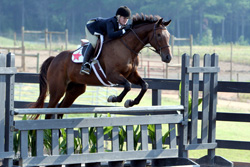 Figure 6: Incorrect front leg technique. This horse is “hanging” its front legs. Notice how the foreleg is not parallel with the ground. A horse that jumps in this manner is considered unsafe since its legs are more apt to be pulled under its body if it hits the obstacle.
Figure 6: Incorrect front leg technique. This horse is “hanging” its front legs. Notice how the foreleg is not parallel with the ground. A horse that jumps in this manner is considered unsafe since its legs are more apt to be pulled under its body if it hits the obstacle.The horse is severely penalized if he jumps with a form that is unsafe, such as hanging its legs or splitting its knees, since these faults make it more likely that the horse will fall if it hits the obstacle since its legs can be pulled underneath its body or a pole could get trapped in its legs (Figure 6).
The horse is also penalized if it jumps from either too close or too far away from the jump. The ideal takeoff point is a distance away from the jump that is roughly equal to the height of the jump (e.g., if the jump is 3 feet high, the takeoff point would be approximately 3 feet in front of the jump). This allows for the horse to comfortably clear the jump without losing or gaining momentum (Figure 7).
.JPG)
.JPG) Figure 7: Ideal takeoff (top) and landing position (bottom) of a horse jumping correctly. The horse leaves the ground at roughly the same distance from the fence as it lands on the other side.
Figure 7: Ideal takeoff (top) and landing position (bottom) of a horse jumping correctly. The horse leaves the ground at roughly the same distance from the fence as it lands on the other side.If the horse leaves from too far away from the jump, it has to push harder off the ground and therefore has an increased momentum as it is landing. The horse also may not be able to get completely over the jump and may fall into it. If the horse leaves from too close to the jump, it must halt its momentum and push upwards very hard to keep from hitting the jump. This causes it to land with a decreased momentum. It also makes it more likely that the horse will hit the jump with its front legs because there might not be enough room to raise them (Figure 8).
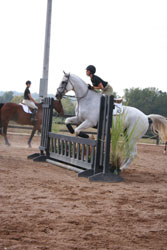 Figure 8: A horse that is too close to the jump. Notice how the horse is more likely to hit the obstacle with its front legs when leaving from too close to the jump.
Figure 8: A horse that is too close to the jump. Notice how the horse is more likely to hit the obstacle with its front legs when leaving from too close to the jump.Overall, the hunter over fences horse should look smooth and rhythmical with very little change in speed throughout the course. It should jump easily and in good form. It should have a pleasant expression and be very obedient. It should not look as though the rider has to work to either slow down or speed up the horse.
Horses are given a subjective score on the scale of 1-100, with scores in the 90s representing excellence both in quality of movement and jumping style, scores in the 80s representing good jumping form and good quality movement or an excellent mover and jumper who makes a minor mistake (e.g., a takeoff distance that is slightly too close or far away, a lead change that is rough but is still a correct flying change). Scores in the 70s denote an average mover and jumper or a good mover/jumper who makes a few minor mistakes. Scores in the 60s represent a poorer mover and/or jumper, or better quality horses that make mistakes (e.g., less than ideal takeoff distances, big changes in speed, a simple or incomplete lead change).
How severely a mistake is penalized is at the discretion of the judge; however, safety should always rank first so mistakes that potentially jeopardize the horse or rider (e.g., very poor takeoff distances, cross cantering, approaching the jump on the incorrect lead) should be faulted more severely than mistakes that are not as dangerous to the horse or rider (e.g., simple lead changes).
Horses are always penalized for knocking down a rail and may be penalized to a lesser extent for a hard rub even if the rail does not fall completely. Typically very light touches on a rail are not penalized except in the case of very close ties.
Scores in the 50s or lower are reserved for major mistakes. A knockdown with the hind legs will result in a score no higher than the 50s, while a knockdown with the front legs is typically considered more dangerous due to the possibility of the horse falling and therefore results in a score no higher than the 40s. Horses are eliminated from the class if they have three cumulative disobediences, including refusals and runouts (running past the jumps or crossing over one's tracks to get back to the jump). Fewer than three major disobediences will not result in elimination but will result in a very low score (typically less than 40).
Hunter Hack
The hunter hack class is meant to be an introduction to hunter over fences. In this class, the horse is required to jump two fences, generally between 2 feet and 2 feet 6 inches in height, that are at least two strides apart. Horses are given a pattern that involves negotiating two jumps as well as performing additional maneuvers such as a change of direction, a hand gallop, a halt and/or a back. Horses perform the pattern individually and are then required to walk, trot and canter on the rail. The jumps are given more emphasis (70 percent) than the rail work (30 percent), and therefore the rail work is mostly used to break ties between horses. The rail work is judged on the same criteria as a Hunter Under Saddle class, and the jumping portion is judged on the same criteria as the Hunter Over Fences class. If asked to hand gallop, the horse should show a definite lengthening of stride and increase in speed. The horse should stop easily and obediently when asked without excessive pulling or head movement.
Western Performance Events
Western disciplines originated from horses being used to work cattle. These horses needed to be comfortable to ride all day and had to be extremely obedient and quick in order to be useful in handling cattle. Today, there are many different western events ranging from classes that judge how well a horse moves and obeys to classes that judge the horse's ability to maneuver obstacles, complete tasks or work cattle in different ways.
Western Pleasure
A Western pleasure class has a similar judging criteria and class format to a hunter under saddle class, differing simply in the function and movement of the horses used for each event. Western pleasure horses are judged on their ability to produce a pleasurable ride; they should appear to be comfortable enough and willing enough to be enjoyable to ride all day. Western pleasure horses will move slower and with a shorter stride than the hunter under saddle horses since their function is not necessarily to cover large amounts of terrain but rather to produce a smooth ride. However, the western pleasure horse should move similarly to the hunter horse in that it should move softly across the ground with very little knee action. It should carry more of its weight on its hindquarters, and the hindquarter should come well under the body when it moves. It should be obedient, have soft and smooth gaits, have a quiet and easy temperament, and be able to be ridden with little restraint (loose reins). The class is judged at the walk, jog and lope in each direction. A jog is a slower trot (still two beats) than a hunter under saddle trot and a lope is a slower canter (still three beats). The horse should carry himself in a quiet and relaxed frame with his head approximately vertical from poll to nose and his poll approximately level with his withers (Figure 9).
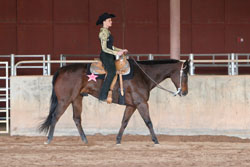 Figure 9: Although this is technically a rider competing in a horsemanship class, the horse demonstrates an acceptable frame for a western pleasure horse, including an acceptable head carriage, coming under itself with its hind legs and a true two-beat jog. It also has a relaxed but alert and pleasant expression.
Figure 9: Although this is technically a rider competing in a horsemanship class, the horse demonstrates an acceptable frame for a western pleasure horse, including an acceptable head carriage, coming under itself with its hind legs and a true two-beat jog. It also has a relaxed but alert and pleasant expression.The western pleasure horse may also be asked to extend its jog and should do so willingly without breaking gait. Horses are penalized if their gait is not “true.” For example, if the horse is supposed to be jogging but is actually walking on its hind end and jogging on its front end it is penalized since it is no longer displaying a two-beat gait. The horse's gait should be correct (e.g., a jog should have two beats and a lope should have three). For example, if the horse is jogging the diagonal pairs of legs should touch the ground simultaneously (e.g., front right and hind left legs should touch the ground at the same time).
Riders use only one hand on the reins and cannot switch hands or touch the rein with their “free” hand. Riders may use two hands if showing in a snaffle bit or hackamore on a junior horse (currently defined by AQHA as five years old and younger). Riders may never ride with two hands when using a curb bit. When using one hand, riders must hold their reins with only one finger between reins if using split reins, and no fingers between the reins if using romal reins. Riders are penalized for incorrect use of the reins, touching the horse or saddle with their free hand or spurring ahead of the girth.
Horses are penalized for excessive speed or slowness, being on the wrong lead, breaking gait, failing to take the gait when called for, head being too high or too low, having the nose out in front of vertical or flexed behind vertical, stumbling or falling, opening the mouth excessively and excessive head movement (AQHA Competitive Horse Judging Manual) (Figure 10).
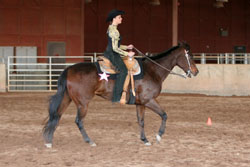 Figure 10: Horse with incorrect frame; the head is too high and the mouth is open in resistance to the rider's cues.
Figure 10: Horse with incorrect frame; the head is too high and the mouth is open in resistance to the rider's cues.Reining
Reining is a western performance event that is judged on the horse's obedience and ability to maneuver easily. The philosophy of reining is that the rider controls every movement of the horse and the horse is willingly guided with virtually no resistance. The horse and rider will perform one of 10 patterns approved by the National Reining Horse Association (NHRA). The specific pattern used at an event is selected by the judge. Maneuvers that are included in a reining pattern are defined as follows:
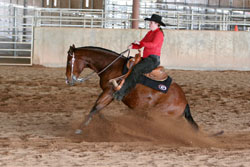 Figure 11: A horse performing a sliding stop. This horse is correctly rounding its back, lowering its head, and allowing its weight to be carried on its hindquarters as it stops. It would be a better stop if the horse would allow its front legs to continue moving until the stop is complete rather than bracing its front legs into the ground, as seen in this picture.
Figure 11: A horse performing a sliding stop. This horse is correctly rounding its back, lowering its head, and allowing its weight to be carried on its hindquarters as it stops. It would be a better stop if the horse would allow its front legs to continue moving until the stop is complete rather than bracing its front legs into the ground, as seen in this picture.Sliding stops: The horse is required to stop by dropping his hindquarters low to the ground while the front end continues to move, thereby allowing the horse to slide to a stop. The stop should look controlled and smooth. The horse should be round at the loin and should lower his head and neck into the stop and should continue moving forward with his front legs rather than bracing (Figure 11).
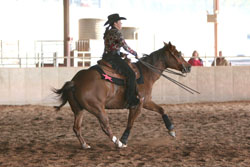 Figure 12: A horse performing a spin to the right (clockwise). Note that the horse's body remains in a fairly straight line with the front end and hind end aligned.
Figure 12: A horse performing a spin to the right (clockwise). Note that the horse's body remains in a fairly straight line with the front end and hind end aligned.Spins: Spins are very quick pivots where the horse's hindquarters remain stationary and the front end pivots quickly around it. Ideally, the spins should be low to the ground and the horse's outside front leg should cross in front of the inside front leg as he spins, allowing the spin to be fluid and quick. The horse should stop the spin in exactly the spot dictated by the pattern, and the front end and hind end should remain in alignment (Figure 12).
Rollbacks: Rollbacks are a combination of a sliding stop and a spin. The horse accelerates into the stop, drops his haunches into the ground and slides to a stop, then immediately spins back the other direction and lopes off. There is no hesitation between the stop and the rollback.
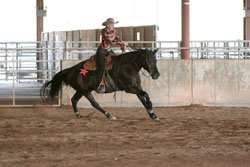 Figure 13: A horse correctly performing a large, fast circle. Note the rider's loose contact with the horse's mouth. The horse willingly moves forward and is guided by the rider.
Figure 13: A horse correctly performing a large, fast circle. Note the rider's loose contact with the horse's mouth. The horse willingly moves forward and is guided by the rider.The horse is also asked to perform circles, either large and fast or slow and small. When performing a large fast circle, the horse should move forward willingly on loose contact. He should look straight ahead and run with speed (Figure 13).
The horse should easily and willingly slow down into a small slow circle. In the small slow circle, the horse should be soft and collected, willingly carrying himself on a shorter stride with his head straight out in front of him flexed at the poll and held about wither height (Figure 14). The horse should make these changes of speed (from a large, fast circle to a small, slow circle and vice versa) with no obvious cue from the rider.
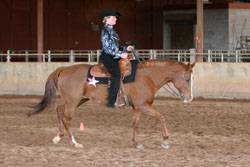 Figure 14: A horse correctly performing a small, slow circle. The horse has willingly shortened its stride with little effort by the rider and is now loping in a collected and relaxed manner.
Figure 14: A horse correctly performing a small, slow circle. The horse has willingly shortened its stride with little effort by the rider and is now loping in a collected and relaxed manner.Lead changes: All lead changes in the pattern should be flying lead changes, unless specified otherwise in the rulebook (certain classes allow the rider to perform a simple lead change by stopping rather than performing a flying lead change). When performing a flying lead change, the horse should change leads with its front and back legs at the same time and the change should be performed exactly in the specified location. The lead change initiates from the hindquarters so a lead change that is performed where the horse changes its front legs first followed by its hind legs is incorrect and will receive a lower maneuver score. The horse will be penalized for changing before or after the point the pattern dictates. Ideally, the lead change will be flat and smooth (e.g., the horse will not jump up into the lead change and the rider will not have to excessively prepare the horse to perform the change).
Throughout all of the maneuvers, the horse should be guided willingly and easily on a light rein. There should be absolutely no resistance to the rider's commands. The horse should be aggressive in his maneuvers but perfectly manageable by the rider. The horse should not be fussy with the bit or his tail (i.e., no excessive mouthing of the bit or swishing of the tail).
Reining patterns are scored on a scale of 1-100 with 70 denoting the average score. Patterns are broken down into specific maneuvers. Two scores, a maneuver score and a penalty score, are applied to each maneuver. These numbers are added or subtracted from 70 to determine the final score. Penalties are deducted at very specific levels for specified disobediences and range from 0 to 5. Maneuver scores are assigned at the judge's discretion based on the quality of the maneuver performed and range from -1.5 to 1.5.
Horses may be disqualified and given no score for the following reasons (NRHA 2011 Official Handbook):
- Abuse of the horse in the show arena or evidence of previous abuse
- Use of illegal equipment
- Use of illegal bits Use of tack collars, tie downs or nosebands
- Use of whips
- Use of any attachment that alters the movement of or circulation to the tail
- Failure to provide horse and equipment to the judge for inspection
- Disrespect by the exhibitor
- Use of closed reins other than standard romal reins
- Unsafe or improper exhibition of the horse at any point
On some occasions, horses are given a score of 0, which will prevent him from placing in the class where the 0 is given but will allow him to continue on in the event in the case of qualifying rounds. The following incidences will result in a score of 0 being given:
- Failure to complete the pattern as written
- Performing maneuvers other than in a specified order, including maneuvers not specified (e.g., backing more than 2 steps when not indicated in pattern, spinning more than 90 degrees where not specified)
- Equipment failure resulting in a delay of completion of the pattern
- Jogging in excess of half of a circle or half the length of the arena when circling, starting a circle or exiting a rollback
- Spinning more than ¼ of a turn past what is specified
- In run-in patterns, coming to a complete stop before the first marker once a canter has been established
- Use of a romal other than in the way indicated in the handbook
- More than index or first finger between the reins
- Using two hands on the reins unless riding a young horse in a snaffle bit or hackamore
- Changing hands on the reins
- Fall to the ground of horse or rider
- Balking or refusing a command
- Running away or failing to guide where it becomes impossible to discern if on pattern
- Dropping a rein that contacts the ground while the horse is in motion
- Failure to wear appropriate western attire as outlined by the NRHA Handbook
Faults that are penalized but do not result in elimination are given scores anywhere from -1/2 to -5 depending on severity. More than one penalty may be applied to each maneuver. The following faults result in a 5-point deduction:
- Spurring in front of the girth
- Using the free hand to instill fear or praise in the horse
- Holding the saddle with either hand
- Any blatant disobedience results in 5 points being deducted per incident (e.g., kicking out, biting, bucking, rearing)
The following faults result in a 2-point deduction per incident:
- Failure to go past the markers on stops and rollbacks
- Breaking of gait
- Freezing up in a spin or rollback
- When using walk-in patterns, failure to stop or walk before executing a canter departure
- On run patterns, failure to be in a canter before the first marker
Other penalties are also defined in the AQHA and NRHA Handbook. Each time a horse is on the wrong lead, one point is deducted. This can be applied to performing circles. When performing circles, one point is deducted for each quarter of the circumference of the circle or any part thereof that the horse is on the incorrect lead. Therefore, if a horse does one complete circle on the wrong lead, this would result in a 4-point deduction (1 point for each quarter). Additionally, a ½ point deduction is made for a change of lead that is delayed by one stride. When a lead change is required prior to a run around the end of the arena (e.g., if the horse has been circling and then is required to exit the circle and run down to and around the end of the ring), points are deducted based on how far he goes into the turn before executing the lead change properly. No points are deducted for an incorrect lead if the horse is running straight down the side of the ring. However, the horse must change to the correct lead before entering the turn at the end of the arena. One point is deducted if he is not on the correct lead when moving into the turn around the end of the arena. If he has not completed the lead change by the center of the end of the arena, 2 points are deducted. For example, if the horse runs down one end of the ring and stops, then performs a rollback turn and runs back in the direction he just came from, it does not matter what lead the horse picks up out of the rollback. However, if he is required to turn left at the end of the arena, he must change to the left lead before he turns.
Deductions are also made for failure to immediately pick up the lope. If the horse jogs up to two steps at the beginning of a circle or when exiting a rollback, ½ point is deducted. If the horse jogs more than two strides (but less than ½ the circle or length of the arena), 2 points are deducted.
When spinning, there are a specified numbers of turns the horse must make. A ½-point deduction is enforced if the horse over or under spins by 1/8 or less of a turn. One point is deducted for over or under spinning by 1/8 to ¼ of the turn.
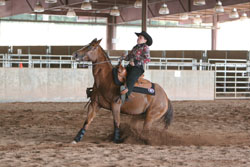 Figure 15: A horse blatantly resisting the rider during a sliding stop. Note the raised head and open mouth. Additionally, this horse has braced its front legs leading to a jarring or “bouncy” stop.
Figure 15: A horse blatantly resisting the rider during a sliding stop. Note the raised head and open mouth. Additionally, this horse has braced its front legs leading to a jarring or “bouncy” stop.The horse must remain at least 20 feet from the wall or fence of the arena when beginning a stop or rollback. If he does not allow this distance, ½ point is deducted. Other faults that are penalized at the judge's discretion include:
- Opening the mouth excessively; mouthing the bit
- Opening the mouth or raising the head significantly when performing sliding stops (Figure 15)
- Stops that are “bouncy” or are not straight (Figure 15)
- Refusing to change leads
- Anticipating signals and performing maneuvers before asked
- Stumbling
- Failure to back in a straight line
- Knocking over any markers in the arena
In addition, the rider can also be penalized for the following actions:
- Feet out of the stirrups (called losing a stirrup)
- Failure to go beyond markers on rollbacks and stops
In addition to penalty points, quality points are added or deducted (the maneuver score). These points are awarded or subtracted based on the judge's opinion of how the horse performed each maneuver. A NHRA judge's scorecard is broken down into a series of different maneuvers. Each maneuver is assigned quality points ranging from +1.5 to -1.5. The scoring breakdown is as follows:
- +1.5 Excellent
- +1 Very good
- +0.5 Good
- 0 Correct
- -0.5 Poor
- -1 Very poor
- -1.5 Extremely poor
For a total score, quality points (maneuver score) and penalty points are totaled together and either added to or subtracted from 70. Placings are determined by total score with the highest score being the winner.
Classes Judged on the Rider
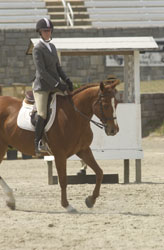 Figure 16: Correct position for the equitation rider. Note that this rider is in the rising phase of the posting trot, which is why her seat is out of contact with the saddle.
Figure 16: Correct position for the equitation rider. Note that this rider is in the rising phase of the posting trot, which is why her seat is out of contact with the saddle.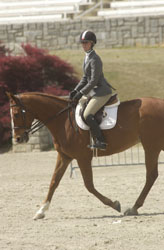 Figure 17: Correct position for the huntseat rider when riding at a posting trot or hand gallop.
Figure 17: Correct position for the huntseat rider when riding at a posting trot or hand gallop.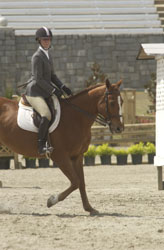 Figure 18: Correct hand and arm position for the huntseat rider.
Figure 18: Correct hand and arm position for the huntseat rider.Huntseat equitation and western horsemanship classes are judged on the position and effectiveness of the rider. Huntseat equitation can be judged on the flat (under saddle classes) or over fences. Proper rider body position for both equitation and horsemanship requires that the person sit in the middle of the saddle with weight being evenly distributed on each side of the horse. A straight line should be able to be drawn from the rider's ear to shoulder to hip to heel (Figure 16).
In equitation classes, riders may incline slightly forward when posting a trot or riding a hand gallop (Figure 17).
When evaluating rider position for equitation, a straight line should be able to be drawn from the rider's elbow to hand to the horse's bit. The hands and arms should be relaxed with the thumbs pointing inwards at a 30-degree angle (Figure 18).
In horsemanship classes, the hand position, as described by the AQHA Handbook, is to hold both hands and arms in a relaxed manner with the upper arms in a straight line with the body (Figure 19).
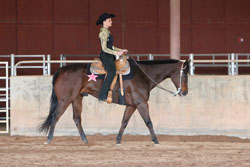 Figure 19: Correct hand and arm placement for the horsemanship rider. Note that the reins are carried in this rider's left hand while the right hand is held at a similar height but does not touch the reins.
Figure 19: Correct hand and arm placement for the horsemanship rider. Note that the reins are carried in this rider's left hand while the right hand is held at a similar height but does not touch the reins.Stirrup length is somewhat longer in horsemanship classes than for the huntseat rider. A straight line should still be able to be drawn from the rider's ear to shoulder to hip to heel. For western horsemanship, the stirrup should be just short enough for the heel to be lower than the toe. Stirrups should be placed on the ball of the foot; riders who have only their toe in the stirrup are penalized.
Horsemanship riders ride with one hand on the reins on senior horses. Riding with two hands is permissible on junior horses if the rider is using a snaffle, bosal or hackamore. The rider's free hand (the one not holding the reins) is held in a position similar to the hand that is holding the reins. Riders should never change rein hands. Reins are carried either directly above or slightly in front of the saddle horn. Rein length should be long enough so that there is some slack in the reins and the rider does not appear to be pulling on the horse but short enough that the rider does not have to move his/her hand excessively to get a response. In both equitation and horsemanship, riders should not move excessively when riding, and riders' cues should be virtually invisible to the onlooker. Favoritism is given to riders who have “invisible aids” (i.e., those riders who can maneuver the horse without the judge seeing the cues the rider has given.)
In equitation on the flat and horsemanship classes, riders are generally asked to execute some type of specified pattern and then proceed to rail work. The rail work is used to break ties after judging the pattern. This test (pattern) will be scored, and there are many scale ranges that can be used. If judging on a 1-20 scale, 10 points can be awarded for overall presentation of the horse and rider, including the rider's position, and 10 points can be awarded for execution of the pattern. The American Quarter Horse Association publishes the following judging guide (out of 20 possible points) in their Official Handbook:
- 20: Excellent equitation including body position and use of aids. Pattern is performed promptly, precisely, and smoothly.
- 18-19: Generally excellent performance with one minor fault in appearance and position of exhibitor or execution of the pattern (performance).
- 16-17: Generally good pattern execution and equitation with one minor fault in precision or execution of pattern (performance), or appearance and position of exhibitor.
- 14-15: Average pattern that lacks quickness or precision, or rider has obvious equitation flaws that prevent effective equitation, or commits two or three minor flaws in the performance or appearance and position of exhibitor.
- 12-13: One major fault or several minor faults in the performance and/or appearance and position of exhibitor that precludes effective communication with the horse.
- 10-11: Two major faults or many minor faults in the performance or appearance and position of the exhibitor.
- 6-9: Several major faults or one severe fault in the performance, or appearance and position of exhibitor. Exhibitor demonstrates a complete lack of riding ability or commits a severe fault in the performance or appearance and position of exhibitor.
- 1-5: Exhibitor commits one or more severe faults in the performance, or appearance and position of exhibitor, but does complete the class and avoids disqualification.
Equitation Over Fences
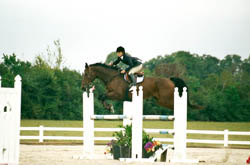 Figure 20: Rider demonstrating good equitation over fences position.
Figure 20: Rider demonstrating good equitation over fences position.Huntseat riders have an additional classification of equitation in which they can compete: huntseat equitation over fences. In huntseat equitation over fences classes, riders are judged on their ability to guide the horse over a course of jumps. In some classes, riders may come back into the ring and do rail work following everyone's completion of the course. Riders are judged on their position and effectiveness. Riders may be inclined slightly forward when jumping the course but their weight should still be centered over the middle of the saddle (similar to riding a posting trot or a hand gallop). The riders will execute a two-point position over the jumps; this is a position where the rider holds himself off the horse's back to allow it to jump freely (Figure 20).
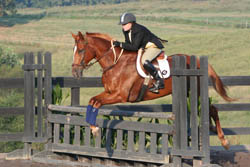 Figure 21: Rider exhibiting poor equitation over fences position. Rider has allowed the weight to come out of her legs and has dropped her weight back into the saddle as the horse is in mid-air.
Figure 21: Rider exhibiting poor equitation over fences position. Rider has allowed the weight to come out of her legs and has dropped her weight back into the saddle as the horse is in mid-air.The rider's weight should be centered over the middle of the saddle and the rider should not interfere with the horse's ability to use its head and neck. Riders who are not centered over the horse in a correct two-point position will have trouble balancing and holding the position and in turn have trouble controlling their horse upon landing (Figure 21).
Riders should smoothly move into and out of the two-point position. They should not pull back on the reins as the horse is jumping or interfere in any way with the horse's ability to jump. Riders are also judged on their ability to make correct decisions to rate their horse's pace and approach the fence properly. If the horse jumps from too close or too far away, the rider is faulted. The judge will evaluate the rider's effectiveness in handling the horse, getting it to the jumps properly and presenting a smooth and effective ride.
Summary
Judging performance classes requires that the judge rank a group of horses or riders based on a criteria set forth for a particular discipline of riding and specific class within that discipline. This publication reviewed some of the common events seen in stock type and sport horse breeds. Riding disciplines for these groups can be divided into two basic groups: huntseat and western events. These two main groups can be further divided into a multitude of performance events. Furthermore, there are numerous breed organizations that host events to showcase the horse breed they represent. Horse gaits and carriage can vary from breed to breed and between riding styles. It is critical to understand specific rules for all classes offered at a horse show or horse judging competition in which you may be a participant.
This publication was extrapolated from Duberstein, K.J. “Judging Riding Classes”. The Art and Science of Livestock Evaluation, Ray V. Herren. Copyright 2010. Delmar/Cengage Learning. Chapter 16: pp. 212-232.
Status and Revision History
Published on Apr 04, 2012
